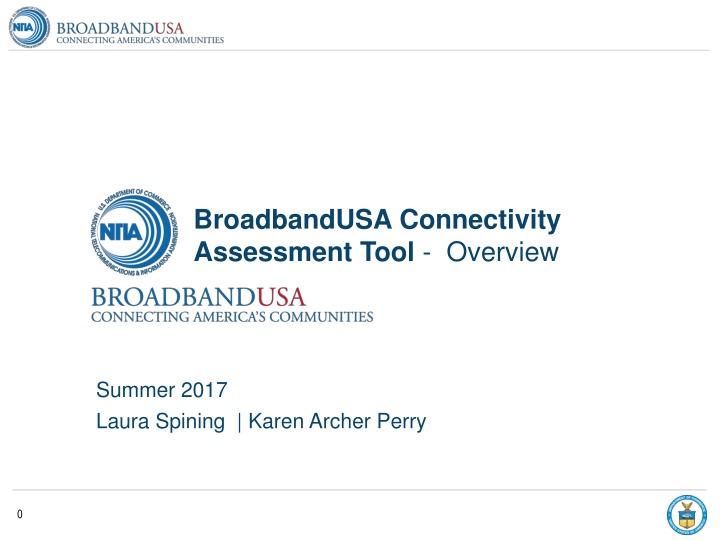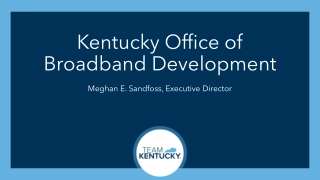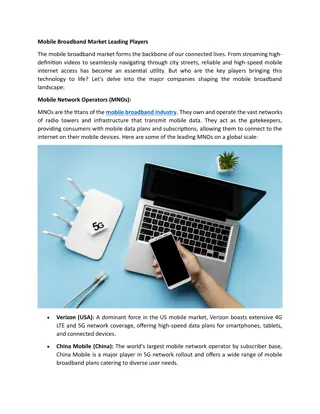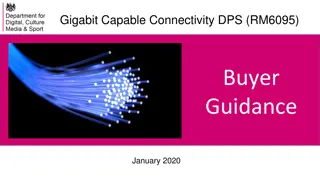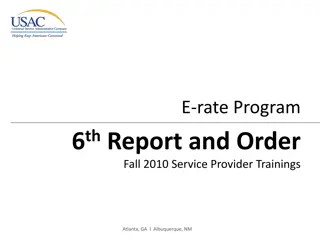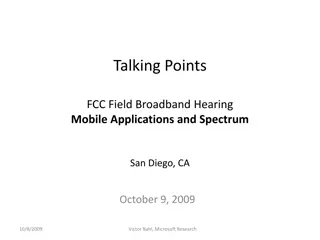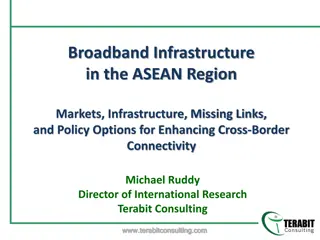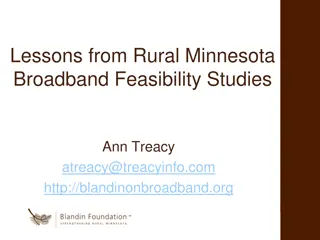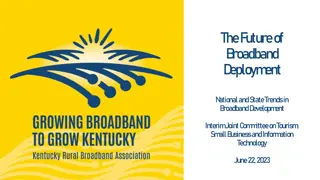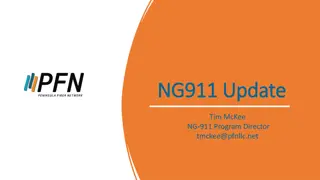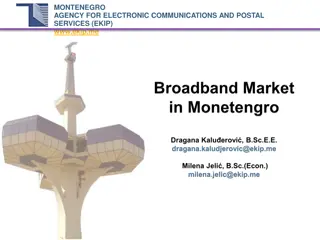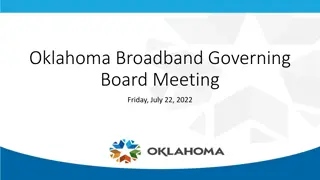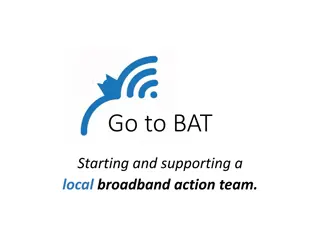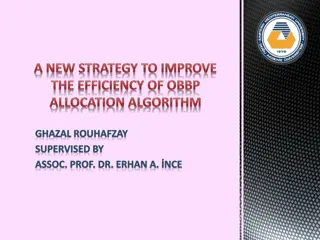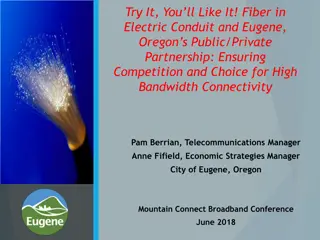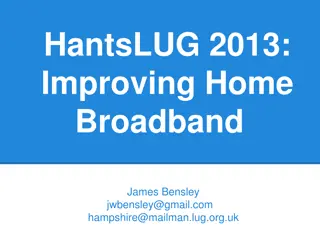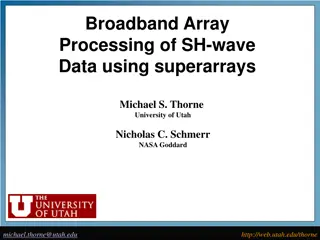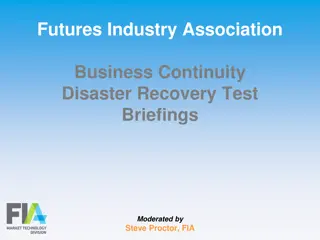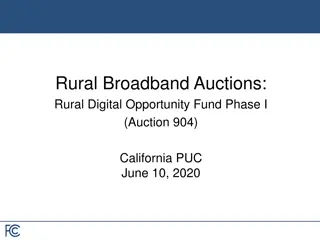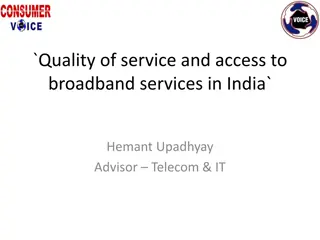Community Broadband Connectivity Assessment and Improvement Strategies
BroadbandUSA's Connectivity Assessment Tool aims to accelerate community broadband planning and action. The tool facilitates better outcomes in less time, engages more communities, and enhances resource relevance and usability. By consulting stakeholders, incorporating measurement programs, and reviewing systems change models, the tool supports structured planning, collaboration, and flexible paths for broadband access improvement. Communities value broadband for economic development, education, public safety, and connectivity. To enhance broadband in communities, creative partnerships, increased education, and investment in infrastructure are essential. Leveraging school and library connections, exploring lower cost solutions like fiber and wireless, and building better business cases are key strategies discussed in the Maine Community Workshop.
Download Presentation

Please find below an Image/Link to download the presentation.
The content on the website is provided AS IS for your information and personal use only. It may not be sold, licensed, or shared on other websites without obtaining consent from the author.If you encounter any issues during the download, it is possible that the publisher has removed the file from their server.
You are allowed to download the files provided on this website for personal or commercial use, subject to the condition that they are used lawfully. All files are the property of their respective owners.
The content on the website is provided AS IS for your information and personal use only. It may not be sold, licensed, or shared on other websites without obtaining consent from the author.
E N D
Presentation Transcript
BroadbandUSA Connectivity Assessment Tool - Overview Summer 2017 Laura Spining | Karen Archer Perry 0
Outline Values NTIA Update Partner comments Beta operations Q and A Leverage Learn Deliver Progress 1
Vision Accelerate community broadband planning, action, and progress. Better outcomes in less time Engage more communities Increase resource relevance & usability Advance broadband access, improve adoption, strengthen policies 2
BroadbandUSA Connectivity Assessment Tool Result Value Process 800+ stakeholders consulted 12 measurement programs incorporated 8 systems change models reviewed Community Connectivity Framework Online assessment tool Platform for additional tools Structured Planning National data Collaboration tool Flexible path Support for action 3
Broadband is important to my community* because Broadband is an expectation including speed and reliability Attracting young families School work and education Community sustainability Connecting communities to each other For island communities, broadband is comparable to the ferry Keeping up with other communities Economic development Work at home Attracting businesses Business diversification Real estate value Seasonable rental Expanding the season Internet is a rental requirement Public safety Aging in place The problem is that we are good enough and good enough isn t going to be good enough any more. *Maine Community Workshop January 2017 4
In order to improve broadband in our community, we need... Open and creative approach to creating partnerships Public private partners will crack the code Reframe the conversation. Broadband IS infrastructure and requires investment More, faster, cheaper, and reliable Increased education and awareness Information, facts and option Lower cost solutions e.g. fiber and wireless Help building better business cases; how do we shift the economics Leverage school and library connections to reach homes and businesses Help reaching small population areas *Maine Community Workshop January 2017 A high fiber diet is healthy for the community. 5
Co-Design Principles What we have heard from you. Encourage robust conversations Fall to local Bias for action Go deep Support flexible paths Facilitate partnership Encourage continuous improvement Surface relevant resources 6
BroadbandUSA Connectivity Assessment Tool Three sectors 12 modules ~160 questions Localized data from U.S Census, NTIA Digital Nation, FCC 477 Action reports Recommended resources 7
Access Broadband Infrastructure and Availability Broadband Access: What wireline and fixed wireless broadband services are available in your area? Mobile Access: What cellular coverage and technology is available in your area? Provider Engagement: Are there opportunities to further strengthen partnerships with existing and new service providers? Public Assets: How do local policies support the use of public assets, enhance advanced telecommunications, and serve the public good? 8
Adoption Digital Inclusion and Workforce Skills Adoption and Use: Who is using the Internet? Are there digital divides? Digital Inclusion: What proactive measures are you taking to ensure digital equity? Digital Skills: Do programs provide a ladder for residents to gain digital proficiencies - from basics to coding? Devices: Do people have access to the devices they need to learn, create and participate? 9
Community Leadership and Context Leadership: Who are the broadband champions in your locality? Community Priorities: What issues draw us to take action to improve broadband? Stakeholder Engagement: How are you engaging stakeholders that can bring interest, influence, or support to local broadband initiatives? Policy Environment: Are there regional or state resources or regulations that impact local planning and investment? 10
What youll Find in Each Module Types of Prompts Informational Scale Scope Narrative Links to local resources Links to share Plus a few others Assessment Scope National data Prompts Responses (local insights) Team responses Summary reports Resource recommendations* *under development 11
Whats in a Module? Data: Providers offering residential broadband services in locality Data: Providers offering business broadband services in locality Provider contacts and relationships Demand projections and aggregation Provider deployment plans Service provider agreements Partnership engagement self- assessment Partnership engagement narrative Partnership engagement links and resources Are there opportunities to further strengthen partnerships with existing or new service providers? 12
You are the Driver Complete planning process on your own schedule Identify your team members; updates are okay Select modules to complete Answer all questions; skip around; select scale only Individual responses and team responses are preserved Responses can be changed Note: Report recommendations links are under development 13
Target Audience: Broadband Planning Teams Geographic communities of all types that want to improve community connectivity and digital equity Elected official City/county manager IT manager or staff Nonprofit or Government Inclusion Champion Citizen advocate or business leaders Tribal leader or IT champion Consumer or business owner Internet service provider 14
User Roles Team Lead Can edit team responses; can edit and publish their own responses; can read published and team responses. Serves as the primary point of contact to NTIA. Team Editor Can edit team responses; can edit and publish their own responses; can read published and team responses. Team Contributor Can edit and publish their own responses; can read published and team responses. Community Participant Can only read published and team responses. 15
Beta Test Objective and Scope Evaluation Scope User flow and process Assessment questions and responses Ease of use Administrative functions incl. user roles Training and support needs Recommended resources Reports and downloads Framework language and structure Benefit and burden hours Areas for improvement Additional planning support; what other tools can BBUSA create to reduce planning cost Objectives Deliver online planning tool Provide localized views of national data Test assumptions and improve Capture feedback to inform future work Identify additional opportunities to support local leaders Provide wrap-around services 16
Thank you beta test communities and partners! 15 communities; 12 users per community; 3 month beta period AL WA ME NCC / NDIA Alexander City Selma Stevens Co Lincoln Co White Center, King Co Piscataquis Franklin Co Lincoln Co Long Island Swan s Island Vinalhaven Charlotte NC San Antonio TX Louisville KY Kansas City MO Partners: ConnectME, Washington State CIO s Office, Washington State Extension Services, Next Century Cities, National Digital Inclusion Alliance 17
For More Information The BroadbandUSA Connectivity Assessment Tool is the first tool in a suite of tools that NTIA BroadbandUSA is creating to support broadband and economic development. Email BroadbandUSA@ntia.doc.gov or call or write: Laura Spining LSpining@ntia.doc.gov (202) 482-5637 Karen Perry KPerry@ntia.doc.gov (206) 861-6043 18
